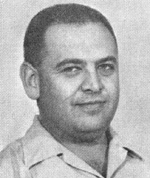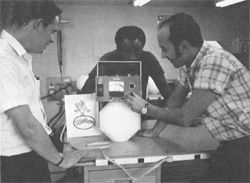The Radiation Physics Section and You
The responsibility of the Radiation Physics Section that concerns the largest number of people is that of protecting people and the environment from nuclear radiation.
If one says "protecting... from nuclear radiations, one implies that nuclear radiations may be hazardous. Indeed, nuclear radiations may be just as hazardous as cooking gas, automobile fuel, electricity, smoking cigarettes, or the cleaning fluid one uses to remove grease spots from clothing.
In our modern society, one learns about the advantages of electricity and learns to avoid electrocution; one learns the convenience of driving cars and how to cross streets carefully as well as not inhaling too long the fumes from the exhaust.
In other words, one learns to trade some convenience for some risk. In fact, many people enjoy smoking so much that they are willing to pay for the "pleasure" with five to ten years of their life!
Nuclear radiations like almost all products of modern technology help make life better and more enjoyable. It is common practice to use nuclear radiations in finding bad teeth, helping set broken bones, search for malignancies in the bodies of the sick, cure or arrest cancer, correct overactive thyroid glands without surgery, etc.
However, nuclear radiations like a medicine, may do good in small amounts and harm in large amounts. Hence, a very important function of the Radiation Physics Section is to teach and help NAL personnel to live with radiation, making sure that neither exposures to personnel or visitors nor radioactivity released into the environment will cause any detectable change in the health of NAL personnel, visitors, or neighbors living just outside NAL's boundaries.
Recently a milestone was reached in the Radiation Physics Section when the first of a family of semi-portable, special nuclear radiation detectors was designed and built. This type of detector will permit anybody at NAL to detect nuclear radiations and know what to do to protect himself from it. Essentially, this detector will provide "radiation eyes" to personnel for seeing and avoiding radiation without the need for a "big brother" to be watching all the time.
(Editor's Note: The device has been named the "Albatross" because of an ancient mariner's tradition that an albatross perched on a mast was a good omen. An early design of this new detector had the 19-pound polyethylene body "perched" on a stand. Now, this handy model can be carried around freely and easily.)





